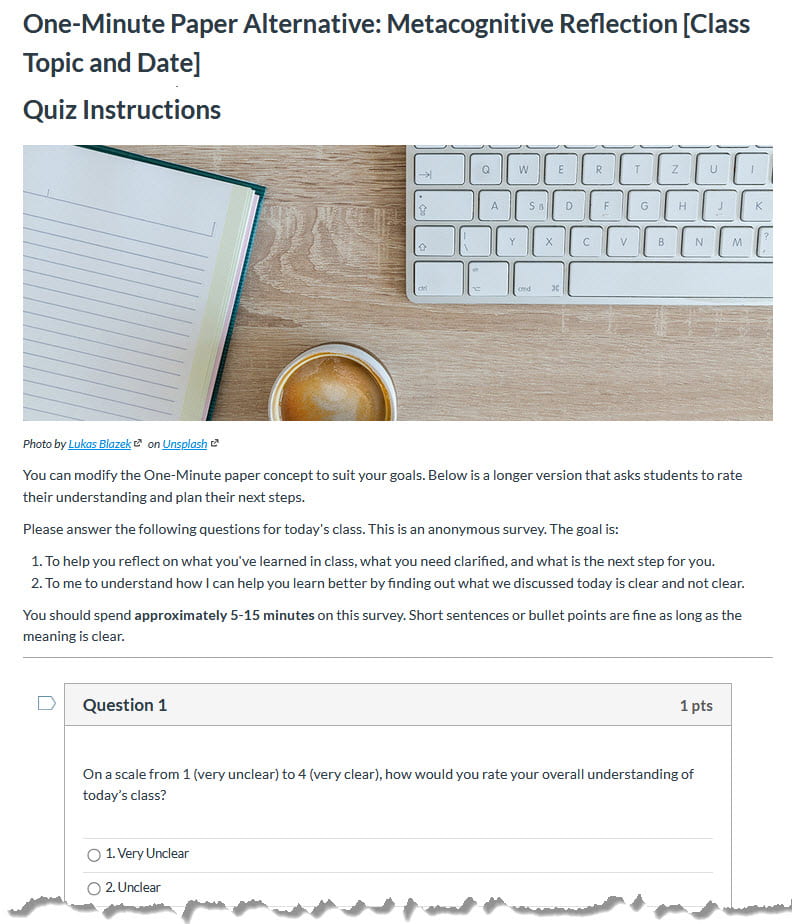Photo by Green Chameleon on Unsplash
Obtaining timely feedback from students on their learning can help faculty and instructors check how well students are learning what they are teaching and decide on whether and what pedagogical adjustments to make. In addition, the act of providing this feedback helps students reflect on their learning, find out what they know and don’t know, and figure out the next steps they need to take to master the content and skills discussed in class.
In this post, we describe how to digitize the One-Minute Paper (in case you run out of time in class), introduce an alternative, longer version that focuses on students’ metacognitive reflection on their learning, and outline a way to promote students’ habits of reflecting on their learning regularly via a digital personal learning journal.
One-Minute Paper

There are many classroom assessment techniques that faculty and instructors can use to collect feedback from students. Among them, the One-Minute Paper (also commonly called the Half-Sheet Response) is one of the most frequently employed because it provides teachers with manageable amounts of timely and useful feedback with little administrative effort. In the One-Minute Paper, students are asked to answer two questions anonymously:
- What was the main point (or points) you learned today?
- What question(s) do you still have?
Despite its name, the One-Minute Paper often takes 5 to 10 minutes of class time, because questions often lead to further questions and reflection takes time. One way to get around the time issue is to conduct the survey digitally via Canvas. The digital version also has the advantage of letting the students keep a copy of their responses for future reference.
A Few Tips
- Reassure students that there are no right or wrong answers, and their responses are important to you because they will help you find out how you can better help them learn and because it is a good way for them to reflect on their learning.
- In the next class, be sure to make it clear to students what you have learned from their responses so that they know that you found their responses useful and are taking actions based on them. Consider letting the class know in advance that you may not be able to comment on every point or question to temper expectations and prevent individual disappointment.
- In Canvas, you have the choice of Graded or Ungraded survey. Graded means students receive a specified number of points when they submit their response. Use the Graded option if you want to provide an incentive for students to complete the survey. If you plan to do several One-Minute Papers over the quarter, you can put them in one Assignment Group and give it a small weight.
- To make submissions anonymous, select the Keep Submissions Anonymous checkbox.
- Select the Let Students See Their Quiz Responses checkbox so that they can see their own answers after they submit their responses. This allows them to reference their own answers when they review for the course.
- Be sure to tell students in the instructions how much time you expect them to spend on the survey and what type of answers (complete sentences, bullet points, etc.) you expect from them.
- Include a due date and time so that students know when they need to complete the survey by.
- Be sure to include the class topic and date in the survey title to remind students what they are responding to.
You can modify the One-Minute Paper to suit your goals. For example, instead of the two questions mentioned above, you can ask students to explain a concept in their own words, say what they found most surprising or applicable, what argument they found most persuasive, what they thought the main objective of the class was, or what relationship they saw between today’s and the previous day’s class. To read more ideas for One-Minute Paper prompts, see Joe Cuseo’s blog post.
Metacognitive Reflection Survey, or Metacognition Sheet

As described in Pooja Aganwal and Patrice Bain’s book Powerful Teaching, the Metacognition Sheet is similar to the One-Minute Paper in that it asks students to make judgments of their learning and/or confidence ratings during learning. In addition to the two questions in One-Minute Paper, this longer version also asks students to
- Rate their overall understanding of the day’s class on a scale.
- Rate their confidence level of what they’ve learned on a scale.
- Write down what they plan to do to improve their understanding of the concepts that were difficult.
According to Nietfeld, Cao and Osborne (2006), having students rate their understanding every class leads to improved self-regulation, which in turn translates into improved performance (p. 159). The affectual side of learning is important because a correct calibration between the confidence level and performance is correlated to a sense of self-efficacy in students for their educational success. Thus, making the affectual side of learning explicit provides faculty and instructors an opportunity to intervene with students who are either under- or overconfident in their performance and help them make the appropriate adjustments. (Note: some cultures disapprove of individuals’ displaying overconfidence; you may need to take this into account before any intervention.)
A Few Tips
In addition to the tips for One-Minute Paper,
- In Canvas, you can create rating scale questions either as multiple choice or dropdown questions.
- Use Canvas’ Quiz Statistics to see the distribution of students’ responses. You will see this link on the right of the survey page after submissions have come in.
Personal Learning Journal
In order for students to become more metacognitive, they must be taught the concept and its language explicitly (Pintrich [2002]; Tanner [2012]). Further, metacognitive skills can only be developed over a period of time (Zohar & David [2009], p. 187). One way to help students become adept at reflecting on their own learning is to assign a personal learning journal in which students document their learning journey at regular intervals and receive timely feedback throughout the quarter.
A Personal Learning Journal can take many different formats. The simplest digital version would be a word processing document to which the student adds continuously over the academic quarter or longer and then submits it. Faculty and instructors can use Canvas assignments to collect these several times over the quarter to provide feedback.
Alternatively, it can also be a one-page website where students summarize their learning journey throughout the quarter. Or it can take the form of a personal blog, where students “blog” about their learning journey in multiple posts. (Here is an example of a learning journal created with the third-party tool Adobe Spark.) The advantage of a web-based “portfolio” or “ePortfolio” is that students can use a combination of text, images, and videos to express themselves, and they can easily upload digital artifacts created during their learning. Faculty and instructors can assign students to create such an ePortfolio using UChicago Voices, or, if linking to student Canvas assignment submissions constitutes a significant part of the portfolio, Canvas’ basic ePortfolio tool may be suitable. In general, UChicago Voices or other web tools are more flexible and allow for more student creativity and are no more cumbersome to manage than Canvas ePortfolio. If you choose to assign a Personal Learning Journal or ePortfolio on UChicago Voices for your course or program, it qualifies for full support by Academic Technology Solutions staff–we will help you set up the site, enroll your students, provide technical support, in-class training, and more.
A Few Tips
- Be sure to plan the student experience and action steps thoroughly–whether you want to include peer learning in this exercise, and how they will share access to their journal or ePortfolio with you.
- Transparency: Make sure learning goals, requirements, and grading criteria are clear to students.
- Guide students on how to use metacognitive language in their reflection.
Understand the technology of choice and know technical support resources. Make sure you are familiar with the technology you chose for your students and how you and they can get help.
Getting Help
If you have any questions about how to use Canvas quizzes or a personal learning journal effectively, or would like help planning these exercises, please contact Academic Technology Solutions for a consultation.
References
- Thomas Angelo and K. Patricia Cross, Classroom Assessment Techniques: A Handbook for College Teachers (San Francisco: Jossey-Bass, 1993), pp. 148-153.
- Chandani Patel, “Acquiring and Using Student Feedback.” (Accessed August 6, 2019.)
- Iowa State University Center for Excellence in Learning and Teaching, “Classroom Assessment Techniques: Quick Strategies.” (Accessed August 6, 2019.)
- University of Rochester, Center for Excellence in Teaching and Learning, “The One-Minute Paper.” (Accessed August 7, 2019.)
- Joe Cuseo, “One-Minute Paper,” On Course website (Accessed August 7, 2019).
- Pooja Aganwal and Patrice Bain, “Ch5 Engage Students with Feedback-Driven Metacognition,” in Powerful Teaching: Unleash the Science of Learning, pp. 142-144 (San Francisco, CA: Jossey-Bass, 2019). See also, Retrieval Practice, https://www.retrievalpractice.org (Accessed August 5, 2019).
- John L. Nietfeld, Li Fen Cao, Jason W. Osborne, “The Effect of Distributed Monitoring Exercises and Feedback on Performance, Monitoring Accuracy, and Self-Efficacy,” Metacognition and Learning 1 (2006): 159-179 (Accessed August 7, 2019).
- Nancy Chick, “Metacognition,” Vanderbilt University Center for Teaching (Accessed August 7, 2019).
- Paul Pintrich, “The Role of metacognitive knowledge in learning, teaching, and assessing,” Theory into Practice 41.4 (2002): 219-225.
- Kimberly Tanner, Promoting student metacognition. CBE—Life Sciences Education 11 (2012): 113-120.
- Anat Zohar and Adi Ben David, “Paving a clear path in a thick forest: a conceptual analysis of a metacognitive component,” Metacognition Learning 4.3 (2009): 177-195.
- Donald Schon, The Reflective Practitioner: How Professionals Think in Action (New York: Basic Books, 1983).
